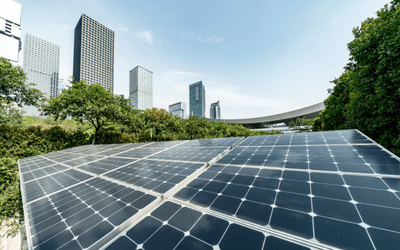As global-scale climate urgency intensifies and technological innovations are discovered, developed, and delivered at pace in response to the challenge of meeting green energy and net zero emissions targets, renewables are becoming the backbone of the energy economy.
But whilst the sector is experiencing a period of unprecedented growth, with no suggestion of slowing down anytime soon, challenges remain.
In this blog we explore the state of the current renewable energy landscape, and look to the near future and beyond to discover the evolving talent demands that will shape the sector for decades to come.
Today: A Renewable Energy Market in Motion
According to the WTW Renewable Energy Market Review, renewable energy now accounts for over 30% of global electricity generation, and this figure continues to climb as investment and innovation accelerate across the sector. Solar photovoltaic (PV) technology stands at the forefront, not only due to its rapidly falling costs but also for its versatility in both utility-scale projects and distributed generation. Wind power, both onshore and offshore, complements this growth, with countries leveraging advanced turbine technology to harness stronger and more consistent winds, particularly offshore. Hydropower remains a foundation in many regions, though its expansion is often limited by environmental considerations and site availability.
As renewables surge, and the adoption and use of such energy sources rise too, we are seeing an increase in the development and delivery of enabling technologies. Battery energy storage systems (BESS) are swiftly being deployed to overcome the intermittency of solar and wind, ensuring grid stability and flexibility.
These trends are underpinned by supportive policy frameworks, ambitious corporate sustainability goals, and a growing recognition that renewables are not only environmentally necessary but increasingly economically compelling. As these dynamics play out, the renewable energy market is poised to redefine the future energy landscape, driving both decarbonization and new talent demands across the globe.
Highlights from the Renewable Energy Market review:
The findings from WTW’s market review highlight a variety of technological and geographical trends from across the renewable energy sector. Here are some of the key facts and figures that are making an impact on the industry:
-
Solar PV is the world’s cheapest form of power and the most prioritized technology globally.
-
Battery storage is rapidly scaling, with 49% of surveyed companies prioritising it over the next five years.
-
Hydrogen is gaining traction, with 44% of companies investing in its development.
-
Floating solar and offshore wind are expanding, especially in Asia.
-
Geothermal, gravity storage, and bioenergy are emerging as viable alternatives.
-
Asia leads global capacity growth, contributing 72% of new renewable capacity in the past decade.
-
North America is seeing surging demand from data centres and AI infrastructure.
-
Europe continues to push offshore wind and circular economy models.
-
Africa and Latin America are embracing hybrid systems to overcome grid limitations.
Tomorrow: Renewable Energy Innovation and Integration
The next phase of renewable energy will be defined by unprecedented integration, innovation, and adaptability. As power systems evolve, there is a marked shift toward hybrid energy platforms that seamlessly blend solar, wind, battery storage, and even hydrogen to provide reliable, round-the-clock clean power.
Advanced grid interconnection technologies are becoming pivotal, enabling the orchestration of diverse sources and smoothing fluctuations in supply and demand. Microgrids and decentralised energy solutions are also gaining momentum, offering communities and businesses resilience in the face of grid instability and natural disruptions.
Looking even further forward, renewable energy innovation is being accelerated by rapid advances in artificial intelligence, automation, and data analytics. Smart grids equipped with real-time monitoring are optimising efficiency and forecasting, while blockchain and digital twin technologies are unlocking new models for peer-to-peer energy trading and asset management. And the rise of space-based solar power, floating renewables, and integrated urban energy solutions will further expand the boundaries of what is possible.
Emerging Renewables trends to look out for
-
According to Global Renewable Energy research by REN21, AI and data centres are driving demand for clean energy, with projections of 44 GW additional load by 2030.
-
Carbon markets and clean manufacturing are creating new revenue streams.
-
Space-based solar power (SBSP) is transitioning from science fiction to pilot phase, WTW found.
-
Circular economy models are gaining traction, focusing on recycling solar panels, wind turbines, and batteries.
Beyond: The Talent Imperative
The renewable energy sector is swiftly evolving, driven by technological advances and the urgent need for decarbonization. This transformation is fuelling significant demand for skilled professionals who can manage complex systems, such as hybrid grids, energy storage, and smart infrastructure. Despite forecasts suggesting up to 38 million renewable energy jobs globally by 2030, a notable skills gap persists, especially in grid interconnection, battery integration, AI, and cybersecurity, and many organisations are struggling to find candidates with the right technical and digital expertise required to meet their talent and skill requirements as new technologies emerge and the renewables job market grows and broadens.
Addressing this gap will demand dynamic recruitment, upskilling programs, and strong partnerships with educational institutions. Ongoing workforce development, government incentives, and industry certifications will be critical to building the talent needed for a resilient, future-ready renewables sector.









